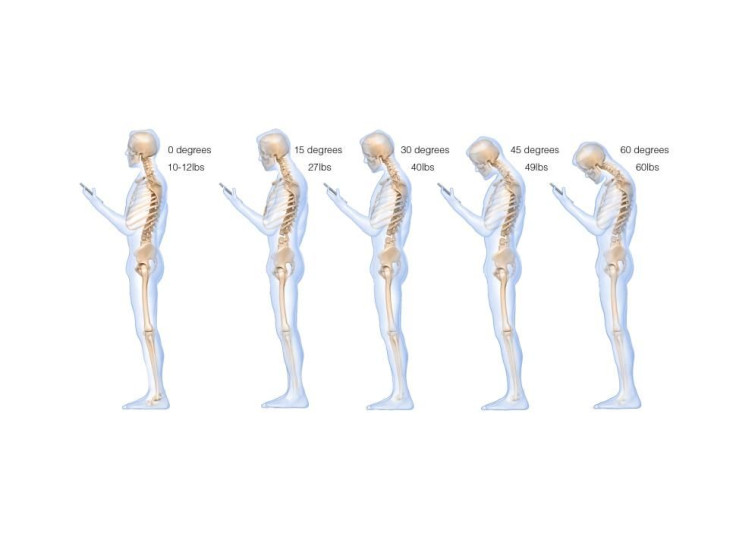Texting Puts 50 Pounds Of Pressure On Your Spine, Adding To Poor Posture's Side Effects

By the time today’s youth reach college, they’ll already be experts at slumping over their cell phones. They will have hit the coveted 10,000-hour mark and their thumbs will deftly move over the virtual keys of their virtual keyboard, their necks bent downward at impossible angles. They might as well have a 7-year-old on their backs.
A new study published in Surgical Technology International finds that texting can add up to 50 pounds of pressure on a person’s spine, depending on the angle at which the person is texting. It upholds a new school of thought in the medical field that deplores many of the modern conveniences we’ve come to love: the toilet, the office chair, and, of course, the cell phone. It’s not that these technologies are necessarily evil, but that evolution has molded our bodies to function best without them. We in the Western world don’t seem to care.
“Loss of the natural curve of the cervical spine leads to incrementally increased stresses about the cervical spine,” wrote study author Dr. Kenneth K. Hansraj, a spinal and orthopedic surgeon.
Your spine is at its happiest when your ears fall on the same plane as your shoulders, and your shoulder blades are retracted. Without these adjustments, you put added stress on your spine, Hansraj says.
“These stresses may lead to early wear, tear, degeneration, and possibly surgeries.”
In his study, Hansraj calculated how stressful varying degrees of curvature would be on a person’s spine. At zero degrees of tilt, the resting pressure is equal to the weight of the person’s head: roughly 10 to 12 pounds. But for each 15 degrees of tilt, the pressure increases. At 15 degrees, a person feels 27 pounds of pressure; at 30 degrees, it ups to 40 pounds; at 45 degrees, 49 pounds; and at 60 degrees, a person should feel roughly 60 pounds of force on the spine.
Many people, upcoming generations especially, essentially grew up in these positions. Much of the entertainment today relies on a screen of some kind, and if it’s not a TV or desktop computer, it’s a tablet or smart phone that sits comfortably in a person’s hand, but at the same time demands the user crane his or her neck to use it. One estimate suggests people use these devices for roughly two to four hours a day, meaning our necks stay bent for 700 to 1,400 hours in a given year. High school students are even worse, Hansraj says. They may hit 5,000 hours before they graduate.
The remedy to our posture problem isn’t to abolish the technologies. They’re an integral part of our lives now, so Hansraj advises us to be a little more mindful with how we use them.
“While it is nearly impossible to avoid the technologies that cause these issues, individuals should make an effort to look at their phones with a neutral spine and to avoid spending hours each day hunched over,” he said.
If we don’t, cervical spine surgeons will have more patients to deal with, Hansraj says. He recommends a dual approach. People should stop holding their phones by their waists, and surgeons should help minimize post-surgery complications by keeping patient behaviors in mind, taking care (as they always should) to avoid reconnecting spinal discs into kyphosis: a curvature of the spine that leads to slouched posture.
Hansraj’s study is the first, he says, to look at the biomechanical drawbacks of slumped-over texting. It can help people be more aware of how they stand. Posture is one of those subtle cues that are really tricky to fix, because it requires dedicated effort to correct. But raising your phone a few inches up your sightline seems easy enough, and it may, quite literally, help take a load off.
Source: Hansraj K. Assessment of Stresses in the Cervical Spine Caused by Posture and Position of the Head. Surgical Technology International. 2014.



























